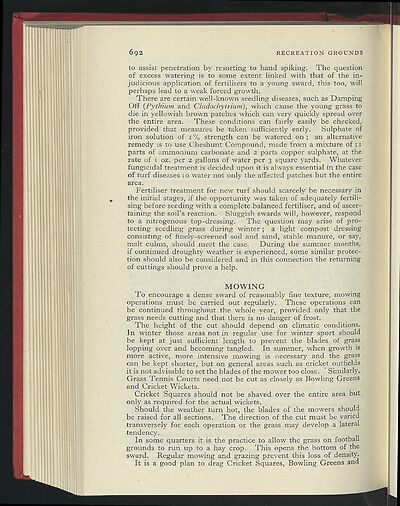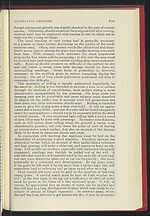1952-53
(726)
Download files
Complete book:
Individual page:
Thumbnail gallery: Grid view | List view

6)92
RECREATION GROUNDS
to assist penetration by resorting to hand spiking. The question
of excess watering is to some extent linked with that of the in-
judicious application of fertilisers to a young sward, this too, will
perhaps lead to a weak forced growth.
There are certain well-known seedling diseases, such as Damping
Off (Yythium
and
Cladoclrytrium),
which cause the young grass to
die in yellowish brown patches which can very quickly spread over
the entire area. These conditions can fairly easily be checked,
provided that measures be taken sufficiently early. Sulphate of
iron solution of
I
% strength can be watered on ; an alternative
remedy is to use Cheshunt Compound, made from a mixture of
I I
parts of ammonium carbonate and
2
parts copper sulphate, at the
rate of i oz. per
2
gallons of water per 3 square yards. Whatever
fungicidal treatment is decided upon it is always essential in the case
of turf diseases to water not only the affected patches but the entire
area.
Fertiliser treatment for new turf should scarcely be necessary in
the initial stages, if the opportunity was taken of adequately fertili-
sing before seeding with a complete.balanced fertiliser, and of ascer-
taining the soil's reaction. Sluggish swards will, however, respond
to a nitrogenous top-dressing. The question may arise of pro-
tecting seedling grass during winter ; a light compost dressing
consisting of finely-screened soil and sand, stable manure, or say,
malt culms, should meet the case. During the summer months,
if continued droughty weather is experienced, some similar protec-
tion should also be considered and in this connection the returning
of cuttings should prove a help.
MOWING
To encourage a dense sward of reasonably fine texture, mowing
operations must be carried out regularly. These operations can
be continued throughout the whole year, provided only that the
grass needs cutting and that there is no danger of frost.
The height of the cut should depend on climatic conditions.
In winter those areas not in regular use for winter sport should
be kept at just sufficient length to prevent the blades of grass
lopping over and becoming tangled. In summer, when growth is
more active, more intensive mowing is necessary and the grass
can be kept shorter, but on general areas such as cricket outfields
it is not advisable to set the blades of the mower too close. * Similarly,
Grass Tennis Courts need not be cut as closely as Bowling Greens
and Cricket Wickets.
Cricket Squares should not be shaved over the entire area but
only as required for the actual wickets.
Should the weather turn hot, the blades of the mowers should
be raised for all sections. The direction_ of the cut must be varied
transversely for each operation or the grass may develop a lateral
tendency.
In some some quarters it is the practice to allow the grass on football
grounds to run up to a hay crop. This opens the bottom of the
sward. Regular mowing and grazing prevent this loss of density.
It is a good plan to drag Cricket Squares, Bowling Greens and
RECREATION GROUNDS
to assist penetration by resorting to hand spiking. The question
of excess watering is to some extent linked with that of the in-
judicious application of fertilisers to a young sward, this too, will
perhaps lead to a weak forced growth.
There are certain well-known seedling diseases, such as Damping
Off (Yythium
and
Cladoclrytrium),
which cause the young grass to
die in yellowish brown patches which can very quickly spread over
the entire area. These conditions can fairly easily be checked,
provided that measures be taken sufficiently early. Sulphate of
iron solution of
I
% strength can be watered on ; an alternative
remedy is to use Cheshunt Compound, made from a mixture of
I I
parts of ammonium carbonate and
2
parts copper sulphate, at the
rate of i oz. per
2
gallons of water per 3 square yards. Whatever
fungicidal treatment is decided upon it is always essential in the case
of turf diseases to water not only the affected patches but the entire
area.
Fertiliser treatment for new turf should scarcely be necessary in
the initial stages, if the opportunity was taken of adequately fertili-
sing before seeding with a complete.balanced fertiliser, and of ascer-
taining the soil's reaction. Sluggish swards will, however, respond
to a nitrogenous top-dressing. The question may arise of pro-
tecting seedling grass during winter ; a light compost dressing
consisting of finely-screened soil and sand, stable manure, or say,
malt culms, should meet the case. During the summer months,
if continued droughty weather is experienced, some similar protec-
tion should also be considered and in this connection the returning
of cuttings should prove a help.
MOWING
To encourage a dense sward of reasonably fine texture, mowing
operations must be carried out regularly. These operations can
be continued throughout the whole year, provided only that the
grass needs cutting and that there is no danger of frost.
The height of the cut should depend on climatic conditions.
In winter those areas not in regular use for winter sport should
be kept at just sufficient length to prevent the blades of grass
lopping over and becoming tangled. In summer, when growth is
more active, more intensive mowing is necessary and the grass
can be kept shorter, but on general areas such as cricket outfields
it is not advisable to set the blades of the mower too close. * Similarly,
Grass Tennis Courts need not be cut as closely as Bowling Greens
and Cricket Wickets.
Cricket Squares should not be shaved over the entire area but
only as required for the actual wickets.
Should the weather turn hot, the blades of the mowers should
be raised for all sections. The direction_ of the cut must be varied
transversely for each operation or the grass may develop a lateral
tendency.
In some some quarters it is the practice to allow the grass on football
grounds to run up to a hay crop. This opens the bottom of the
sward. Regular mowing and grazing prevent this loss of density.
It is a good plan to drag Cricket Squares, Bowling Greens and
Set display mode to:
![]() Universal Viewer |
Universal Viewer | ![]() Mirador |
Large image | Transcription
Mirador |
Large image | Transcription
| Games and sports in the army > 1952-53 > (726) |
|---|
| Permanent URL | https://digital.nls.uk/248826946 |
|---|
| Description | 'Games and Sports in the Army' was an annual publication produced by the British War Office between the 1930s and 1960s. This included the Second World War. It outlines the rules and regulations for games and sports played by members of the armed forces. It features names and photographs of team members, and examples of contemporary advertising. |
|---|---|
| Shelfmark | GWB.52 |

